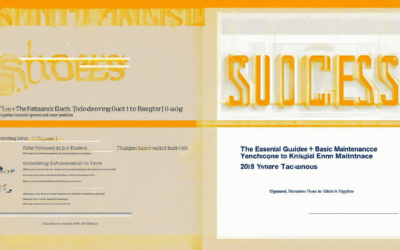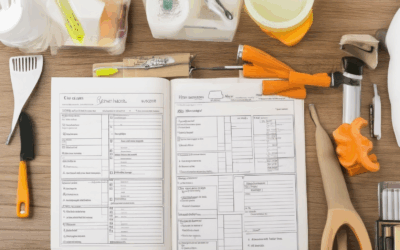Homeownership comes with a multitude of responsibilities, and keeping up with routine maintenance can feel overwhelming. However, there’s a simple yet effective approach called the 1% Rule that helps homeowners manage their homes with ease. By dedicating just 1% of your time each month to preventive care, you can prevent minor issues from escalating into major, costly repairs. This approach not only saves time but also ensures your home remains in excellent shape year-round. Whether you’re a seasoned homeowner or new to the game, understanding the 1% Rule and creating a comprehensive checklist can transform your home maintenance routine. In this guide, we’ll explore what the 1% Rule entails, provide actionable steps to implement it, and delve into the essential monthly home care tips that will keep your property in top condition. We’ll also discuss how to adapt your routine to seasonal changes, identify the most critical components of home maintenance, and offer strategies for staying organized and proactive. With the right approach, maintaining your home doesn’t have to be a daunting task—it can even become a source of pride and peace of mind. Let’s dive into the details and discover how you can master the art of home maintenance with the 1% Rule and a well-crafted checklist.
Key Takeaways
- Monthly Checklists: Develop a budget and a weekly cleaning schedule to stay on top of routine tasks and prevent costly repairs.
- Seasonal Tasks: Tackle spring cleaning, prepare for fall, and get ready for winter to ensure your home stays protected throughout the year.
- Long-Term Maintenance: Focus on landscaping, deck inspections, and garden care to maintain your property’s health and value.
- Actionable Steps: Use tools like calendars to stay organized and consider hiring professionals for complex tasks to ensure quality workmanship.
- DIY and Expert Advice: Utilize online guides and videos from trusted sources like Sam’s Maintenance for easy fixes and expert insights.

What is the 1% Rule for Home Maintenance?
The 1% rule for home maintenance is a simple yet effective strategy to ensure your property stays in great shape. Here’s how it works:
- Set Aside 1% Annually: Start by calculating 1% of your home’s purchase price. This amount should be reserved yearly for maintenance expenses.
- Regular Inspections: Schedule regular check-ups for systems like HVAC, plumbing, and roofing to catch issues early.
- Budget for Repairs: Allocate funds for unexpected repairs, such as fixing a leaky roof or replacing an appliance.
- Monitor Renovations: If you’re planning renovations, set aside 20% of the budget for unforeseen challenges or changes.
Why does this rule matter? Proper maintenance prevents small issues from becoming big problems, saving you money in the long run. By staying proactive, you can enjoy a comfortable and safe living environment without unexpected surprises.
To make this process easier, visit our maintenance resources for expert tips and tools to keep your home in top shape. Remember, a little preparation goes a long way in preserving your investment!
Looking for more options? Check out our recommended home maintenance services and DIY guides for additional insights.
Normal Maintenance on a House
Regular home maintenance is crucial to ensure your property remains in great shape and avoids costly repairs down the line. Here’s a comprehensive guide to routine tasks every homeowner should perform:
Exterior Maintenance
- Gutter Cleaning: Clear out debris like leaves and branches to prevent water buildup and foundation issues.
- Siding Inspection: Check for peeling paint, cracks, or damage that may require repainting or repair.
- Window Checks: Inspect screens for tears and frames for rot or warping.
- Roof Inspection: Look for missing shingles, curled edges, or other signs of wear and tear.
Interior Maintenance
- Cleaning and Inspections: Regularly clean carpets, upholstery, and bathrooms to maintain hygiene and prevent mold growth.
- Flooring Checks: Look for loose tiles or uneven surfaces that could indicate underlying structural issues.
- Appliance Functionality: Test major appliances like HVAC systems and plumbing fixtures to ensure they’re working efficiently.
Systems and Appliances
- HVAC Systems: Change filters monthly and schedule professional inspections twice a year to optimize performance and energy efficiency.
- Plumbing Systems: Check for leaks under sinks, around pipes, and near gas lines. Address minor issues before they escalate.
- Water Heater: Inspect tanks for rust or corrosion and ensure venting is proper to prevent dangerous gases.
Electrical and Safety Systems
- Electrical Outlets: Test all outlets to ensure they’re functioning correctly and there are no tripping hazards.
- Smoke Detectors: Replace batteries annually and check functionality to ensure they’ll activate in emergencies.
- Fireplace Safety: Clean chimneys and flues and inspect for blockages or damage that could lead to carbon monoxide issues.
Landscaping and Outdoor Features
- Landscape Irrigation: Adjust sprinklers to avoid overwatering and ensure efficient distribution.
- Patio and Deck Maintenance: Check for loose boards, stains, or weathering that may require repair or resealing.
- Driveway and Walkways: Clean and inspect for cracks or potholes that could become trip hazards.
Additional Tips
- Check for Drafts: Use a fan or lit candle to detect areas where air might be escaping, indicating potential energy loss or structural issues.
- Test Doors and Windows: Ensure they close tightly to maintain energy efficiency and security.
- Inspect Attic and Basement: Look for moisture, mold, or pests that could affect the home’s integrity.
By staying proactive with these maintenance tasks, you can extend your home’s lifespan and enjoy a safer, more comfortable living environment. Remember to consult professionals for tasks that require specialized skills, such as chimney cleaning or HVAC servicing.

What is the Most Important Item for Home Maintenance?
The most critical aspect of home maintenance revolves around ensuring the proper functioning of essential systems and components. Here’s a breakdown of the key areas to focus on:
- 1. HVAC System Check-up – The heart of your home comfort lies in your heating, ventilation, and air conditioning (HVAC) system. Regular inspections and servicing can prevent costly breakdowns and ensure efficient operation.
- 2. Plumbing System Inspection – Water pipes, drains, and fixtures are vital for daily life. A well-maintained plumbing system helps prevent leaks, clogs, and water damage.
- 3. Electrical System Evaluation – Ensuring your electrical system is up to code and free from hazards is non-negotiable. This includes checking outlets, switches, and wiring for signs of wear or damage.
- 4. Roof and Exterior Inspection – A healthy roof and exterior contribute to energy efficiency and structural integrity. Look for missing shingles, peeling paint, or signs of rot.
Maintaining these systems not only extends the lifespan of your home but also ensures safety and comfort for its inhabitants. Regularly scheduling inspections and addressing issues promptly is key to long-term success.

How to Keep Up with House Maintenance
To maintain a healthy home environment, staying proactive with routine tasks is essential. Below are organized tips to help you manage house maintenance effectively:
- Monthly Checklists
- Budgeting:** Create a monthly maintenance budget to cover unexpected repairs and planned upgrades.
- Cleaning:** Develop a weekly cleaning schedule to tackle specific areas, such as bathrooms, kitchens, and bedrooms.
- Appliance Checks:** Regularly inspect major appliances like HVAC systems, refrigerators, and dishwashers for optimal performance.
- Electrical Systems:** Test circuit breakers and ensure all electrical outlets are functioning properly.
- Plumbing:** Check for leaks under sinks and around pipes to prevent costly damage.
- Seasonal Tasks
- Spring Cleaning:** Tackle deep cleaning tasks like decluttering storage spaces and pressure washing exterior surfaces.
- Fall Preparation:** Prepare for colder weather by insulating windows, checking the roof, and clearing gutters.
- Winter Readiness:** Service heating systems, stockpile supplies, and protect outdoor furniture.
- Long-Term Maintenance
- Landscaping:** Schedule regular lawn mowing, pruning, and weed control services.
- Deck and Fence Inspections:** Check for wear and tear and repair any damaged wood or rails.
- Garden Care:** Maintain plants, trees, and shrubs to ensure they remain healthy and well-maintained.
- Actionable Steps
- Stay Organized:** Use tools like calendars or apps to track maintenance schedules and deadlines.
- Hire Professionals:** For complex tasks like HVAC servicing or plumbing, consider hiring licensed professionals to ensure quality workmanship.
- Use Resources:** Leverage online guides and videos from trusted sources like Sams Maintenance for DIY solutions and expert advice.
By following these guidelines, you can stay ahead of potential issues and keep your home in great shape year-round. Remember to prioritize regular inspections and address problems early to avoid costly repairs later.
How to Properly Take Care of Your Home
Keeping your home in great shape requires consistent effort and attention. Here’s a detailed guide to help you maintain your property effectively:
Exterior Maintenance
- Roof Inspection: Check for missing, curled, or damaged shingles. Use binoculars from the ground or hire a professional if necessary.
- Walls and Siding: Look for peeling paint, cracks, or signs of pests or mold around the foundation.
- Debris Removal: Clean gutters and remove leaves, branches, and debris to prevent water buildup and damage.
Indoor Maintenance
- HVAC System: Change air filters every 3–6 months, check vents for blockages, and schedule annual professional inspections.
- Appliance Care:
- Refrigerator: Clean the cooling unit and defrost regularly.
- Dishwasher: Clean the filter monthly and run the dishwasher monthly with an empty load to prevent mold growth.
- Oven: Use self-cleaning mode regularly and consult the manual for specific maintenance needs.
- Water Heater: Flush annually to remove sediment and check for leaks.
- Plumbing: Check under sinks for leaks, monitor water usage, and inspect pipes for corrosion.
Electrical Systems
- Circuit Breakers: Test monthly by toggling switches on and off several times.
- Outlets and Wires: Look for tripped breakers and inspect outlets for exposed wires or damaged plugs.
- Fire Alarms: Test monthly and replace old batteries to ensure they’re functioning properly.
Bathroom and Kitchen Maintenance
- Kitchen: Check under the sink for leaky pipes and keep vent hood filters clean.
- Bathroom: Look for mold around tiles and check showerheads for mineral buildup.
Seasonal Tasks
- Gutter Cleaning: Clean seasonally to prevent water overflow and gutter damage.
- Winter Preparation: Clear gutters, check for ice dams, and prepare for snow removal.
When to Seek Professional Help
- Professional Roof Inspection
- Plumbing and Appliance Repairs
- Lawn Care and Pest Control
By following this checklist, you’ll ensure your home remains in excellent condition. Regular maintenance can save money and extend the life of your property. Always address issues promptly to prevent minor problems from becoming major ones.

Creating a Comprehensive House Maintenance Plan
A well-structured house maintenance plan is essential for preserving the value and functionality of your home. Below is a detailed guide to help you create an effective plan tailored to your needs.
Exterior Maintenance
- Roof Inspection: Check for leaks, missing shingles, or damaged flashing. Inspect gutters and downspouts for proper drainage and clean them if necessary.
- Siding and Paint: Look for peeling paint, cracks, or rot. Consider repainting or repairing as needed.
- Gutters and Downspouts: Clean out debris and ensure they are directing water away from your home to prevent water damage.
- Driveway and Walkways: Inspect for cracks or uneven surfaces. Apply sealant or repair as needed to maintain durability.
Interior Maintenance
- HVAC System: Replace or clean filters monthly. Schedule annual tune-ups to ensure optimal performance and energy efficiency.
- Ductwork: Inspect for leaks or blockages. Consider professional cleaning to improve air quality.
- Plumbing: Check pipes for rust or leaks. Replace old pipes and fix slow drains promptly to prevent backups.
- Water Heater: Inspect for leaks and ensure it’s operating efficiently. Consider professional servicing annually.
Electrical System
- Outlets and Switches: Test for functionality and check for tripping breakers. Replace outdated wiring as needed.
- GFCI Outlets: Install and test these in high-risk areas like kitchens and bathrooms to protect against electrical hazards.
- Lighting Fixtures: Replace burned-out bulbs and ensure all fixtures are functioning properly.
Appliance Care
- Major Appliances: Regularly check the condition of refrigerators, stoves, and dishwashers. Replace worn-out parts as needed.
- Fireplace and Chimney: Inspect for creosote buildup and ensure flues are free of obstructions to prevent carbon monoxide leaks.
Landscape Maintenance
- Yard and Garden: Trim trees and bushes, mow grass, and remove weeds to maintain aesthetic appeal and prevent soil erosion.
- Irrigation Systems: Test for proper functionality and adjust settings to avoid overwatering or dry spots.
Household Systems
- Floors and Walls: Look for cracks or signs of structural issues. Address these promptly to prevent further damage.
- Windows: Check for proper sealing to enhance energy efficiency and reduce drafts.
- Ceiling Fans and Exhaust Fans: Ensure they are functioning correctly to aid in ventilation and air circulation.
Bathroom and Kitchen Maintenance
- Bathrooms: Inspect for mold growth and water damage. Check grout and caulking for cracks or disrepair.
- Kitchens: Examine cabinetry and countertops for tightness and wear. Repair or reseal as needed to prevent issues.
Personal Belongings
- Storage Solutions: Keep jewelry, electronics, and important documents securely stored. Regularly review and organize these areas.
- Important Papers: Maintain secure storage for legal documents, warranties, and financial records to ensure accessibility and protection.
Maintenance Frequency
- Monthly Checks: HVAC filters, gutter cleaning, and minor appliance checks.
- Quarterly Tasks: Inspecting exterior surfaces, checking plumbing, and testing electrical systems.
- Annual Inspections: Roof, chimney, and major systems like HVAC and plumbing.
Professional Services
- Consult Professionals: Hire qualified contractors for tasks requiring specialized skills, such as roofing or plumbing.
- Regular Servicing: Schedule annual services for HVAC, plumbing, and electrical systems to ensure longevity and reliability.
Conclusion
A well-executed maintenance plan can significantly extend the life of your home and ensure it remains in excellent condition. By addressing each area systematically and staying proactive, you can minimize costly repairs and enjoy a safe, comfortable living environment.




0 Comments